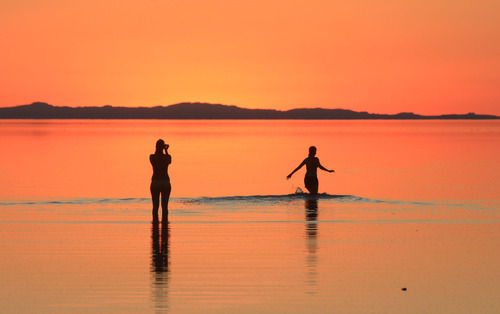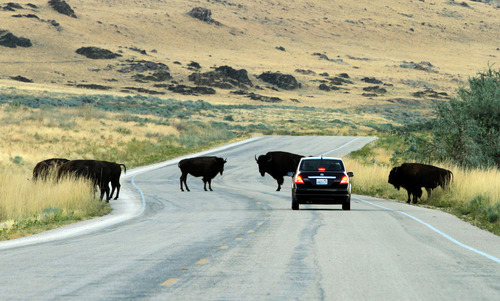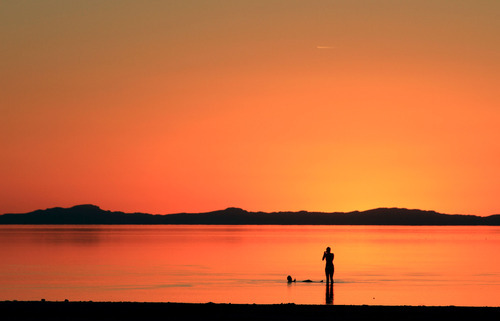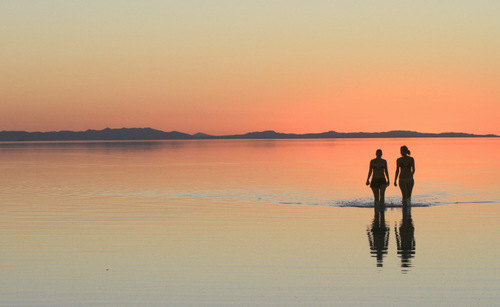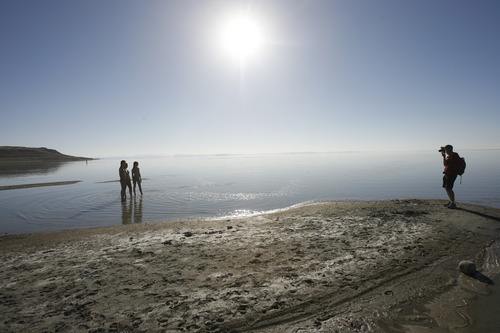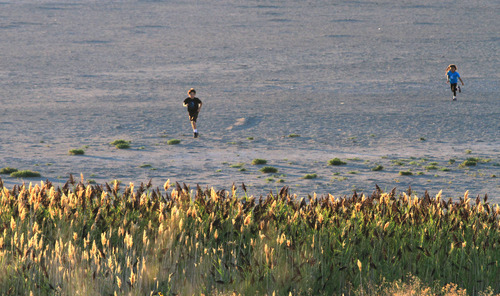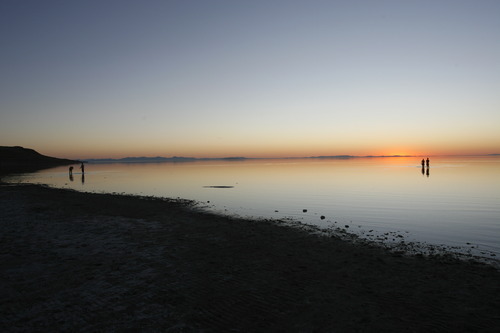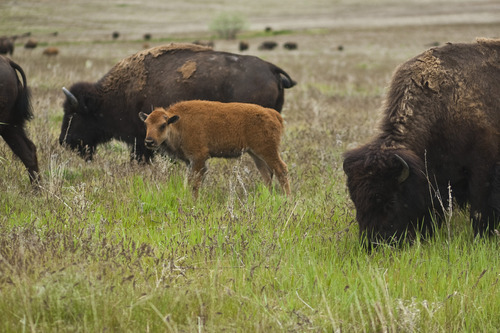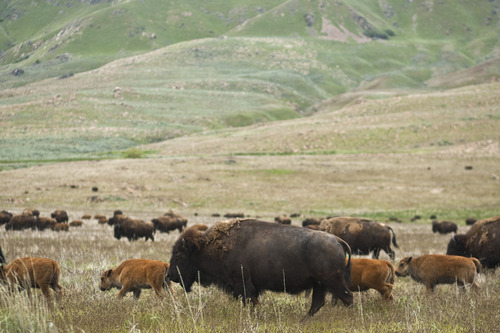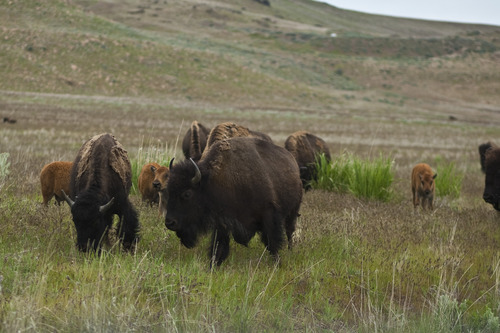This is an archived article that was published on sltrib.com in 2011, and information in the article may be outdated. It is provided only for personal research purposes and may not be reprinted.
Antelope Island State Park • Chase Lovendahl stood on Buffalo Point taking pictures of the Great Salt Lake. The 12-year-old from Springfield, Ore., liked the landscape shots but wanted something a little closer up.
Lifting his digital camera to the eyepiece of the stationary spotting scope mounted on a high point of the island, Lovendahl hit the shutter.
"Look, it worked," Lovendahl said last week while holding up the camera and showing a picture of nothing in particular.
Asked what he thought of his trip to Antelope Island, the pre-teen contemplated for a minute and said, "it is kind of like Yellowstone and kind of like the ocean."
The largest island on the Great Salt Lake is indeed unique among the 43 units in the Utah State Parks system.
Like Yellowstone in that bison jams are not uncommon on the east side of the island. Those with sharp eyes may also notice pronghorn — also known as antelope — mule deer, bighorn sheep, coyote, hawks, owls, birds and a million or so shorebirds.
Like the ocean in that the Great Salt Lake, the largest natural lake west of the Mississippi, was mistaken by early explorers as the Pacific Ocean. And sunsets on the Great Salt Lake can easily be compared to those on the West Coast of the United States.
With no golf course, no water skiers and no fishing, Antelope Island still managed to make it as one of the top 5 most visited state parks in Utah in 2010. And, if more locals figure out what a gem the island is, Antelope Island State Park could perhaps vie for the top spot.
Few people have witnessed the wonder the island holds more than Neka Roundy. While staffing the tiny former visitors center at the Antelope Island marina back in the mid-1990s, Roundy learned firsthand why most people love to drive across the causeway to the state park.
"Everybody wants to float in the Great Salt Lake, and Antelope Island is the best place to experience everything the lake offers," said Roundy, with Davis County Community and Economic Development. "And the sunsets just melt into the water."
In fact, Lovendahl had made it his No. 1 goal during his trip to the island to float in the lake. He heard about the phenomena from his aunt, Beth Garn, whom he was visiting.
"I told him a story about when I fell into the lake while rowing [with a sculling team] on the lake and how I couldn't believe how high I floated," said Garn, a mother of two toddlers from Syracuse. "Swimming in the Great Salt Lake is not something you can do just anywhere."
Garn, apparently, has experienced the lake and the island more than most Utahns. In addition to her rowing experiences, she also rode in the annual Moonlight Bike Ride in July.
According to state parks officials, 56 percent of visitors to the island in 2008 live outside of Davis County and traveled more than 25 miles to get to the park.
A large number of visitors were also visiting from outside of Utah, and 30 percent of survey respondents said Antelope Island was the primary destination.
A French couple snapping pictures of the husband head-butting the white bison at the visitors center said Antelope Island was an important part of planning their trip to the American West.
Phil and Missy Wisniewski, of Findley Lake, N.Y., planned a day on Antelope Island after a co-worker at Penn State heard they were headed to Salt Lake.
"He said we had to come to the island and see the Great Salt Lake," Phil Wisniewski said.
The couple was on vacation — dreaming of moving to the West — and on their way to Grand Teton, Yellowstone and Glacier national parks. Not bad company for an island in a salty lake.
The Wisniewskis were most interested in the wildlife of the island and were thrilled after spotting bison and pronghorn, but were a little shaken up with an encounter with a snake on a trail.
"After hand-tallying pages from the guest book at the visitors center for years and years, we discovered that the places where people come from to see the island are the same as the numbers the Office of Tourism has for the state," Roundy said. "If California is No. 1 for Antelope Island than it is the same for the state. If Germany leads for European visitors than it matches for all of Utah."
Roundy is convinced that anyone visiting the island, particularly locals, will become a fan for life. She wants to see the state do more to promote the wonder of Antelope Island.
Iconic Utah trademarks are displayed on state license plates and Roundy thinks it is time the Great Salt Lake and Antelope Island are given well-deserved attention.
"We have a private commercial company with a plate [Ski Utah] and a federal plate [Delicate Arch]; it is time we have a license plate showing something owned by the state," she said.
Antelope Island facts
385,390 visitors in 2010, 5th most among Utah State Parks
Is 28,022 acres, 15 miles long and 4½ miles across at its widest point.
At 6,596 feet above sea level, Frary Peak is the highest point.
Twelve bison were released on the island in 1893 by a private rancher. A herd of between 500 and 700 currently lives on the island.
273,510 visitors in 2009 generated approximately $3.7 million in Davis County.
Source: Utah State Parks —
Antelope Island annual Events
Easter Egg Hunt • Easter Weekend
Great Salt Lake Bird Festival • mid-May
Cowboy Legends, Cowboy Poetry and Music • Memorial Day weekend
Moonlight Bike Ride • mid-July
Kite and Hot Air Balloon Festival • Labor Day weekend
Bison Roundup • Last week in October
Working of the Bison: • First week in November
Source: Utah State Parks —
Tribune series: The issues facing Utah's state parks
July 3 • Utah's 43 state parks are reeling from budget cuts, which have slashed general funding from $12.2 million to $6.8 million in recent years.
July 3 • Rock Cliff Nature Center at Jordanelle State Park closed July 1 as a result of budget cuts. Additionally, 23 full-time state parks position were eliminated.
July 11 • Edge of the Cedars Museum, the largest federal depository for artifacts in the Four Corners, is holding on, despite being listed second on the Legislature audit's list of facilities under consideration for closure.
July 12 • Camp Floyd/Stagecoach Inn State Park and Museum has gone from what was essentially a restroom stop into a money-generating venture.
July 17 • The Utah State Legislature recommended eliminating law enforcement positions in Utah State Parks. Rural law enforcement agencies fear the changes could leave them shorthanded in times of need. Agency officials worry about public safety in the parks due to the reductions. Also, an update on ranger Brody Young, who was shot nine times during a patrol in 2010.
July 19 • Utah owns five golf courses managed by state parks. One, Wasatch Mountain, makes money, but the rest lose money — and Green River is in danger of closing.
July 25 • One of the most difficult challenges managing an urban playground in northern Utah is dealing with a booming number of people crashing the gates for half the year and then preparing for them during the other six months. Challenges for small, rural water parks, such as Huntington Reservoir, are even greater.
To read the stories, visit > http://www.sltrib.com/topics/parks



